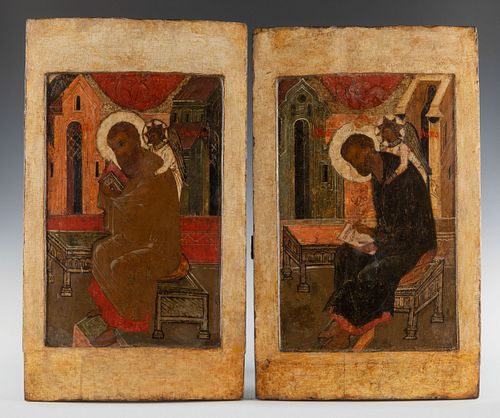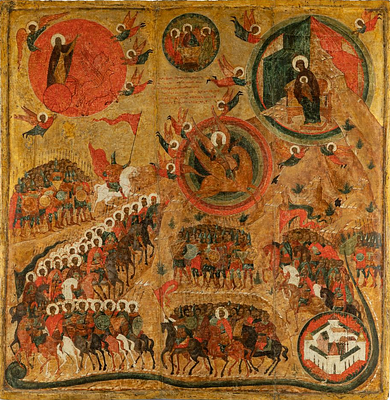Russian school, ca.1600. "Saint Matthew and Saint Luke. Tempera on panel.
Lot 4
About Seller
Setdart Auction House
Carrer Aragó 346
Barcelona
Spain
Setdart Subastas was born in 2004 and is currently the first online art auction in Spain with solidity, prestige and reliability guaranteed by our more than 60,000 users. Setdart has a young, dynamic and enterprising team ready to successfully manage the purchase and sale of art works through custom...Read more
Estimate:
EUR€6,000 - EUR€7,000
$6,250 - $7,291.67
Absentee vs Live bid
Two ways to bid:
- Leave a max absentee bid and the platform will bid on your behalf up to your maximum bid during the live auction.
- Bid live during the auction and your bids will be submitted real-time to the auctioneer.
Bid Increments
| Price | Bid Increment |
|---|---|
| EUR€0 | EUR€10 |
| EUR€200 | EUR€25 |
| EUR€500 | EUR€50 |
| EUR€1,000 | EUR€100 |
| EUR€3,000 | EUR€200 |
| EUR€5,000 | EUR€500 |
| EUR€10,000 | EUR€1,000 |
| EUR€20,000 | EUR€2,000 |
| EUR€50,000 | EUR€5,000 |
About Auction
By Setdart Auction House
Sep 23, 2021
Set Reminder
2021-09-23 10:00:00
2021-09-23 10:00:00
America/New_York
Bidsquare
Bidsquare : RUSSIAN ICONS
https://www.bidsquare.com/auctions/setdart-auction-house/russian-icons-7431
Setdart Auction House sofia@setdart.com
Setdart Auction House sofia@setdart.com
- Lot Description
Russian school, ca.1600. "Sant Mateo and San Lucas. Tempera on panel. Measurements: 56.5 x 35 cm and 55.5 x 35 cm. The pair of icons on auction shows Saint Matthew and Saint Luke, two of the Four Evangelists together with Saint Matthew and Saint John the Apostle. Both panels, whose similar morphology indicates that they were executed by the same anonymous artist, follow the usual arrangement established for the representation of the Evangelists in Russian iconography. Thus, both figures are presented seated in the foreground on a perfectly delineated stone bench. While Saint Luke writes his Gospel, Saint Matthew reads his Scriptures. On the backs of both are figures of winged angels, in the case of Luke symbolising the tetramorph of the prophet Ezekiel and in the case of Mark, the angel who guides him; in the background are two architectural structures framing the figures of the Evangelists. In terms of workmanship and aesthetics, this pair of panels can be dated to around 1600, the period when the art of icons flourished in Russia, when the most famous painters of ancient Russia, Theophanes the Greek, Andrei Rubliov and Dionysius, created their masterpieces. The present lot is therefore in the orthodox tradition. They are dominated by the use of red (symbolising love but also the blood and suffering of Christ) or gold (the colour of God and his light). Saint Matthew the Evangelist was one of the twelve apostles chosen by Jesus, and the author according to Christian tradition of the Gospel that bears his name. He is mentioned in the Acts of the Apostles, and also in the Gospel of Luke, under the name of Levi. Matthew is identified with a winged man or angel, a symbol of the tetramorph of the prophet Ezekiel. This association is due to the fact that his Gospel begins with a review of the genealogy of Christ, the Son of Man and also the Son of God. Saint Luke the Evangelist is considered by Christian tradition to be the author of the Gospel that bears his name, and also of the Acts of the Apostles. He was Paul's beloved physician, though not an apostle of Jesus, of probable Syrian origin, possibly converted to the Christian faith when the followers of Jesus, persecuted in Jerusalem and Caesarea, sought refuge outside Palestine, carrying with them the message of Christ. The first portrait of the Virgin is also attributed to him and he is considered the patron saint of painters.
- Shipping Info
-
In-house shipping available. Please inquire at admin@setdart.com.
-
- Buyer's Premium



 EUR
EUR CAD
CAD AUD
AUD GBP
GBP MXN
MXN HKD
HKD CNY
CNY MYR
MYR SEK
SEK SGD
SGD CHF
CHF THB
THB















